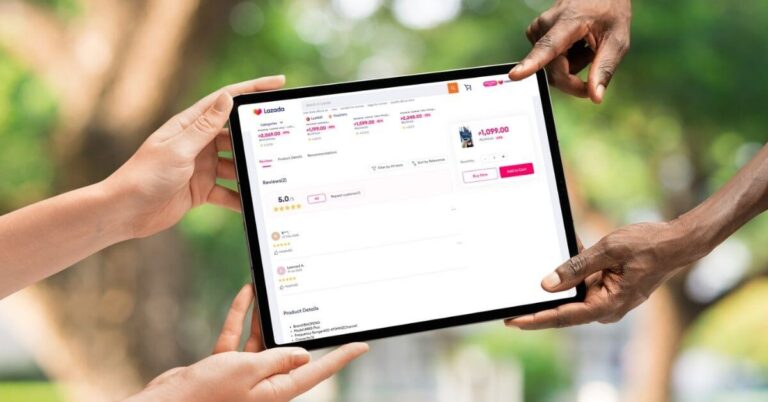Let’s be real—shopping online in the Philippines is no longer just a convenience. It’s part of everyday life. By 2025, more than 70 million Filipinos are expected to shop online. That’s like the entire Luzon island glued to their phones, scrolling, adding to cart, and checking out while waiting for the jeep, sipping coffee at a sari-sari store, or even during a quick lunch break.
And here’s the twist. People aren’t just opening Lazada or Shopee anymore. A new trend is making waves—social commerce in the Philippines.
Table of Contents
What Exactly Is Social Commerce?
Think of it this way. Instead of clicking a Facebook ad and being redirected to a random website, you can now buy the product directly inside the app. One tap. Done. No detours.
The poster child of this trend? TikTok Shop 2025. Its like an entertainment and shopping had a baby. You’re watching a dance video or a quick skincare hack, and suddenly, there’s a “Buy Now” button below. You don’t even leave the app—you just tap, pay, and it’s on the way.
Why do people love it so much?
- It’s smooth. Checkout feels faster than lining up for fish balls at the kanto.
- It’s viral. Remember howlike when Dalgona coffee took over during lockdown spread like wildfire? Products do the same on TikTok.
- It is real and you see actual people using it, not just stock photos. That builds instant trust.
This is why social commerce is exploding. It doesn’t feel like “shopping.” It feels like part of the fun.
The Boom of Live-Stream Shopping
Now, let’s talk about another big thing—live-stream shopping Philippines. Imagine this you’re lying in bed late at night, casually scrolling, when a live stream pops up. Someone’s testing out a ₱299 kitchen gadget, answering viewer questions, and giving a quick demo. Within minutes, the comments section is flooded with “Mine!” and “Add to cart!”
Sounds familiar? That’s live-stream shopping. It’s basically the modern version of home shopping TV—but way more interactive and addictive.
Why it works:
- People trust what they can see in action.
- Hosts create urgency. “Only 50 stocks left, mga besh!”
- Buying feels like joining the hype train with everyone else in the chat.
For sellers, this is gold. Instead of spending thousands on ads, they can go live, build a connection, and sell out in real time.
AI Shopping Personalization—Your App “Knows” You
Here’s where things get a bit high-tech. One of the hottest online shopping trends 2025 is AI shopping personalization.
What does that mean? Your shopping app is basically paying attention to what you do—what you click, how long you watch a video, what you’ve bought before. Then it shows you items you’re most likely to buy.
Ever noticed how after checking out sneakers, you suddenly see socks, shoe cleaners, and sports bags in your feed? That’s AI at work. It feels almost creepy sometimes—like the app knows you better than your barkada. But it works.
Globally, around 75% of shoppers now expect personalized recommendations. In Asia, it’s even higher. Filipinos are no different—we want apps that “get us” without wasting time.
What Filipino Shoppers Really Want
When it comes to online shopping, Pinoys are all about getting sulit. Filipinos are pretty practical when it comes to shopping. We want a good balance—something affordable, but still decent in quality and convenient to buy. Too cheap and it won’t last; too pricey and it feels like a rip-off.
So what’s on everyone’s carts this 2025? A few favorites keep popping up:
- Clothes and fashion basics — everyday shirts, dresses, and accessories that don’t drain the wallet.
- Gadgets and accessories. Phones, earphones, chargers—the stuff we use every single day.
- Wellness must-haves. Skincare, vitamins, or even a yoga mat for home workouts.
- Eco-friendly swaps. Reusable cups, bamboo toothbrushes, tote bags—small changes that make a difference.
And let’s be real, we’ve all tried the super cheap option at least once. Like that ₱50 charger from a random shop that stops working after a few days. These days, more Filipinos would rather pay a bit more—say ₱200—for one that lasts months. It’s not about being “kuripot,” it’s about being smart.
Omnichannel Service & Smarter Payments
Another shift shaping social commerce in the Philippines is how people connect with sellers. Buyers no longer want to wait days for a reply. If they send a question on Messenger or WhatsApp, they expect a quick answer—sometimes within minutes. Apps like LINE and SleekFlow make this easy for businesses.
And let’s talk payments. Cash-on-delivery still exists, but many shoppers now prefer GCash, Maya, or even Buy Now, Pay Later (BNPL) options.
Smarter Payments for Shoppers
Take this for example: a college kid has been eyeing a new phone. Dropping ₱10,000 in one go? Medyo mabigat. But with Buy Now, Pay Later, they can stretch the payments out over time. Less pressure on the wallet, but still walking around campus with that fresh gadget.
That’s why for today’s sellers, flexible payments aren’t just a nice add-on—they’re practically expected. If you’re not offering GCash, Maya, or BNPL, you’re losing buyers who don’t want the hassle of exact cash or full upfront payments.
Tips for Sellers in 2025
Keeping up with shoppers today isn’t rocket science. At the end of the day, it’s about showing up where people already spend their time—and making buying as painless as possible.
A few ideas sellers are using right now:
- Try going live often. Doesn’t have to be a big production. Even a quick 15-minute stream where you chat, demo a product, and answer a few questions can move stocks fast. It’s like talking to customers at your stall, just with comments flying on the screen instead of people lining up.
- Use AI tools wisely. They help match products to the right people without extra ad spend.
- Highlight value. Bundles, freebies, or discounts—Filipinos always look for sulit.
- Stay eco-conscious. Younger buyers especially notice sustainable packaging and products.
- Offer more ways to pay. The easier checkout feels, the faster carts turn into sales.
Think of it this way: if your tindahan only accepted cash, you’d miss out on customers who only have coins for jeepney fare. Same logic online.
The Future of Social Commerce in the Philippines
So, what’s next? Honestly, we’re already in it—scroll, tap, checkout. It’s just how we shop now.
Platforms like TikTok Shop 2025 keep pulling in curious buyers, live streams are turning late nights into shopping sprees, and AI-powered suggestions make it easier to spot things you didn’t even know you wanted. Shopping here won’t look like the old days ever again.
For buyers, that means more choices, more convenience, and more sulit finds while scrolling.
For sellers, it’s a wide-open playing field—as long as you’re willing to adjust and keep up with the trends.
So the next time you’re just killing time on TikTok and a “Buy Now” button pops up under a funny video, don’t be surprised. It’s not just another post—it’s today’s version of window shopping, only faster and way more tempting.


